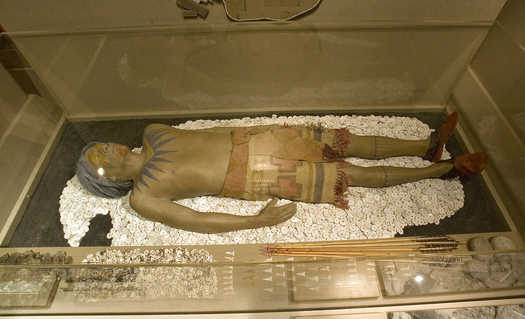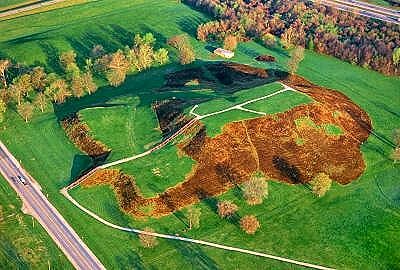
© Tim Vizer/BNDThe Mound 72 display at the Cahokia Mounds museum
Human sacrifice! Victims buried alive! Read all about it in
Cahokia -- Ancient America's Great City on the Mississippi.According to this new book by University of Illinois archaeologist and professor of anthropology Tim Pauketat, the mound builders were not always the idyllic, corn-growing, pottery-making, fishing-hunting gentle villagers depicted in various dioramas at the Cahokia Mounds State Historic Site in Collinsville.
Pauketat said these long-vanished people practiced human sacrifice of women and men on a mass scale and weren't always careful to bury only the dead.
Based on years of study of artifacts including many from the extensive excavation of the site's Mound 72 during 1967-71, Pauketat's book is getting national attention.
The Washington Post described it as "undeniably hot." A national online review service used the headline, "Sacrificial virgins of the Mississippi".
But the "virgins" angle may be a bit of an overstatement, said Pauketat, but not by much.
"In the book I do not use the word virgin. I used female sacrifices," he said, noting that close study of the pelvic area of some of 53 female skeletons found in a huge pit below the mound showed clear signs of childbirth.
"They were selecting women of a certain age, but it's not like they're selecting virgins," he said. Most of the sacrificial victims were in their early 20s, he said.
The existence of 260 skeletal remains including of women all retrieved from within and under Mound 72 was not previously unknown in the metro-east. But because of the book, it's sensational news in other parts of the country, especially in big Eastern cities where residents are unfamiliar with the Midwest's often savage early history.
Pauketat said that the vast collection of data from the mound excavation included reports from the original archaeologist who found
finger bones extended deep into the sand below some of the skeletons, evidence that victims were alive when buried.
"That's the interpretation of the original excavator. He's quite sure of that. I talked to him in person," Pauketat said.
"Basically, the book came together after we reached a critical threshold, all of the little pieces started falling into place. A lot of pieces from the Mound 72 dig are important because they help make sense of all the other pieces that have been found."
Ancient Cahokia, which reached its peak about 1150 A.D. with a population of 20,000, was a religious center of farmers and hunters that probably influenced much of what archaeologists call the Southeast Ceremonial Complex, a string of similar but smaller sites found from Illinois to northern Florida.
It was abandoned about 100 to 200 years later and its descendants are believed to be the various tribes from historic times. At the time of its zenith, Cahokia rivaled London in population and was America's most-populous city until Philadelphia eclipsed it in the 18th century.

Aerial view of Monks Mound, largest prehistoric structure north of Mexico City
About 80 of the original 120 mounds survive, including Monks Mound, the largest prehistoric earthen structure north of Mexico.
In this society, often referred to as the Mississippian Culture, women played much more of a role than convenient sacrificial victims, Pauketat said. And even in this death ritual, women were respected, unlike some of the men whose remains were found with heads lopped off.
"The women never show injury. There is no trauma. So that means either they drank poison or they were strangled. But, that's speculation. They were very carefully placed into these pits," he said.
Ancient Cahokia's big draw, according to the book, was religion. And in the practice of various religious rites,
evidence has been found that women were the rivals of this society's male religious leaders.
Pauketat said the evidence is in the form of curious female figurines carved from a type of clay found just south of St. Louis known as flint clay. The reddish substance dries rock hard.
Just last month, a small, 4-inch high female figure was found at a state-run archaeological dig in East St. Louis. Pauketat said only 23 other such figurines are known, including the largest, about 16 inches high.
The elevated status of women in religion in Cahokian society is illustrated, Pauketat said, by the decorations on the figurines that include a highly prized serpent figure, and of depictions of staple foods like corn and squash. On some figurines, baskets that have been interpreted as holding the bones of ancestors also have been carved into the statues.
"Clearly, a lot of the artwork of female gods and female figureheads show that women were probably highly elevated at Cahokia."
Pauketat said that at Cahokia, religion drew people from small farming villages all over the metro-east and from where present day St. Louis stands.
"People recognized in that place (Cahokia) a supernatural power on a scale and of a kind that was probably unknown in North America north of Mexico," he said
As for the female sacrifices, Pauketat said important women may have been chosen because of their status.
"These female sacrifices might not have been of unimportant people. This may have been a very honored role to fill. It may have been people who were impersonating some kind of corn goddess," he said, "And their duty was to die."
Reader Comments
to our Newsletter